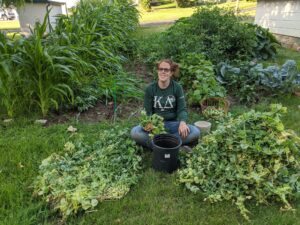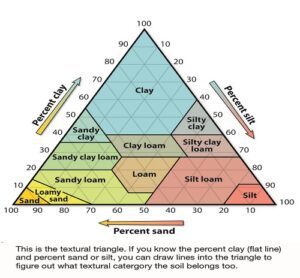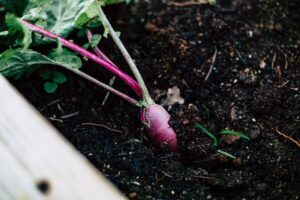March 31, 2022
Soil Testing To Prepare Your Spring Garden
Soil Testing To Prepare Your Spring Garden
Soil testing might sound intimidating, but the better you know your soil, the better you can grow your garden! Ready to break down the basics of soil testing and how it can help you achieve your garden goals?
We sat down with True Organic’s awesome R&D Agronomist, Margaret McCoy, PhD, for the inside scoop (or should we say—shovel) on soil testing and why it’s a vital step for a vibrant home garden.
TRUE: So what is soil testing? What does it tell us?
Margaret McCoy: “Soil testing will give you a baseline idea of what’s going on in your soil and how it relates to what you want to grow. You’ll take a composite sample of your soil — whether that’s a field, a raised bed, your yard — and test it for physical and chemical properties, like pH and nutrient makeup.”
Margaret told us some good things to look for in your soil test results:
- A healthy profile of macronutrients: nitrogen (N), phosphorous (P), and potassium (K)
- Good calcium levels (which helps with cell structure and integrity)
- And pH. “pH is really important but a ‘good’ pH is dependent on what you’re growing,” Margaret reminds us!
And some not-so-great things:
- Heavy metals
- High sodium levels
- Other general chemicals that may have leached into soil from industrial areas, lawn care, former agriculture on that land, etc.
TRUE: Why is soil testing important for a home gardener?
MM: “For a homeowner, you want to understand the properties of the soil you have, because you can’t really change your piece of land.
Getting a picture of what’s in your soil will give you a better understanding of how and where to grow the plants you want to grow. If it’s been a yard for 25 years, it might have an excess or deficiency of certain nutrients that you’ll need for the plants you want to grow. Maybe you’re bringing topsoil in, and you want to know exactly what’s in that — because whatever is in your soil will transfer to your plants!
It’s especially important to know what’s in the soil if you live in a subdivisions or developed lot, where there could be little to no topsoil — so your nutrients may be really low, because it’s a subsoil.
Beyond the basics, it’s also important if you think it’s a safety concern. Maybe at some point in the past, there was agricultural activity on that land and now there are chemicals in the soil that you don’t want in your garden.
 How To Do A Soil Test
How To Do A Soil Test
The simplest way to get a comprehensive soil test is to find a kit online or at your local garden and home improvement store, which will have instructions and a special package in which you’ll send your soil to a lab. You’ll take some samples with a trowel from around your growing space, mix those together, and send it off to be tested.
“A home gardener is probably only interested in the top six inches of soil,” Margaret recommends. “Take a few samples from the various spaces that you want to grow in.”
And what about those results?
“You’ll likely just see a bunch of numbers and not know what it means!” says Margaret.
Find a local Master Gardener, Margaret suggests, to help you understand the results of your soil test and how to address them for your needs. Both NC State and Penn State Extension have great resources on this.
What’s In A Soil Test?
We asked Margaret for some more notes about soil test discoveries and what they mean.
 Soil Profile
Soil Profile
A soil texture test will show you how much sand, silt, and clay are in your soil. These inorganic particles are a highly influential aspect (along with organic matter) of the soil texture and structure.
Margaret gave us a less scientific but fun and kid-friendly test to do at home: “You can even do a jar test to see the different parts of your soil. Put some soil in a jar and shake it up so it becomes suspended (the particles will disperse throughout the water). You’ll see the particles fall out of suspension over time, biggest first. The really small clay particles could take days to settle out from the solution.”
“Even if you have a nice loamy soil on top, but underneath there’s clay, water will pool on top of the clay layer. With water sitting there, you’ll get water-logged plants.”
Unfortunately, there’s not a whole lot you can do about your piece of land’s soil texture. “In that instance,” Margaret says, “you may decide to grow in raised beds instead. That way, you can mitigate that overall heartbreak at the end when you realize none of your plants are surviving, which might not be your fault!”
 Soil pH
Soil pH
Any gardener knows how important soil pH is to growing veggies. Margaret’s first word of advice for dealing with low pH soil? Go with it! If you already have low pH soil, lean toward growing plants that like it.
Many lovely landscaping plants grow very well in low pH soil, including rhododendron and azaleas, holly, and flowering trees like magnolia and dogwood. Most vegetables thrive in neutral pH soil, but you can try potatoes, radishes, peppers, and pumpkin in more acidic soil.
The next step to addressing your garden’s soil pH is to use supplements. “Something like prilled sulfur is a fast-acting option to lower pH,” Margaret says. “You can also spread some lime on your soil to raise it, which takes a bit more time.”
As always, research your plant’s needs before planting, ask questions at your local nursery, or consult an almanac.
Organic Matter & Nutrients In Soil
Increasing the organic matter and good-for-plants nutrients in soil is something we at True Organic take seriously. The organic movement in the United States was founded with the vision of increasing the carbon in our agricultural lands!
Organic matter content is an invaluable aspect of soil’s overall health, especially when it comes to water retention and supporting the essential microorganisms that live in soil and help plants thrive.
“Organic matter is so important when it comes to drainage, “Margaret says. “Having good water-holding capacity in soil is equivalent to pore space — how much space there is between the particles to actually hold water. If you have a really tightly packed soil, you’re not going to have a lot of space, so it’ll either pond on top or you won’t have a lot of movement.”
If your soil test is deficient in organic matter and/or the macro/micro nutrients that are essential for plant life (the most important being nitrogen, phosphorus, and potassium), never fear. Adding high-quality composted materials to your land for organic matter and using organic fertilizers is the best way to start increasing these vital ingredients of healthy soil. We crafted our TRUE farm-grade organic plant foods just for this reason.
“Do I Need to Soil Test My Home Garden?”
Sometimes gardening is just a stress reliever, and you’re less concerned with optimizing your yield or you’re not growing food that will end up on your table. And to you, Margaret says: have fun! Don’t worry too much about the extra-technical aspects of garden and soil unless that helps you have fun and feel good about growing plants. Because that’s the whole point, right? To grow plants and feel good about it.
Read More Articles by True Organic
Stylish, Space-saving Vertical Gardening at Home
June 23, 2023
Caring for Rare Plants with Expert Elana
September 20, 2021
6 Tips for a Perfect Pollinator Garden
March 8, 2023
Show us your True Organic Plants
#GrowWithTrue
www.trueorganic.earth

 How To Do A Soil Test
How To Do A Soil Test Soil Profile
Soil Profile Soil pH
Soil pH



